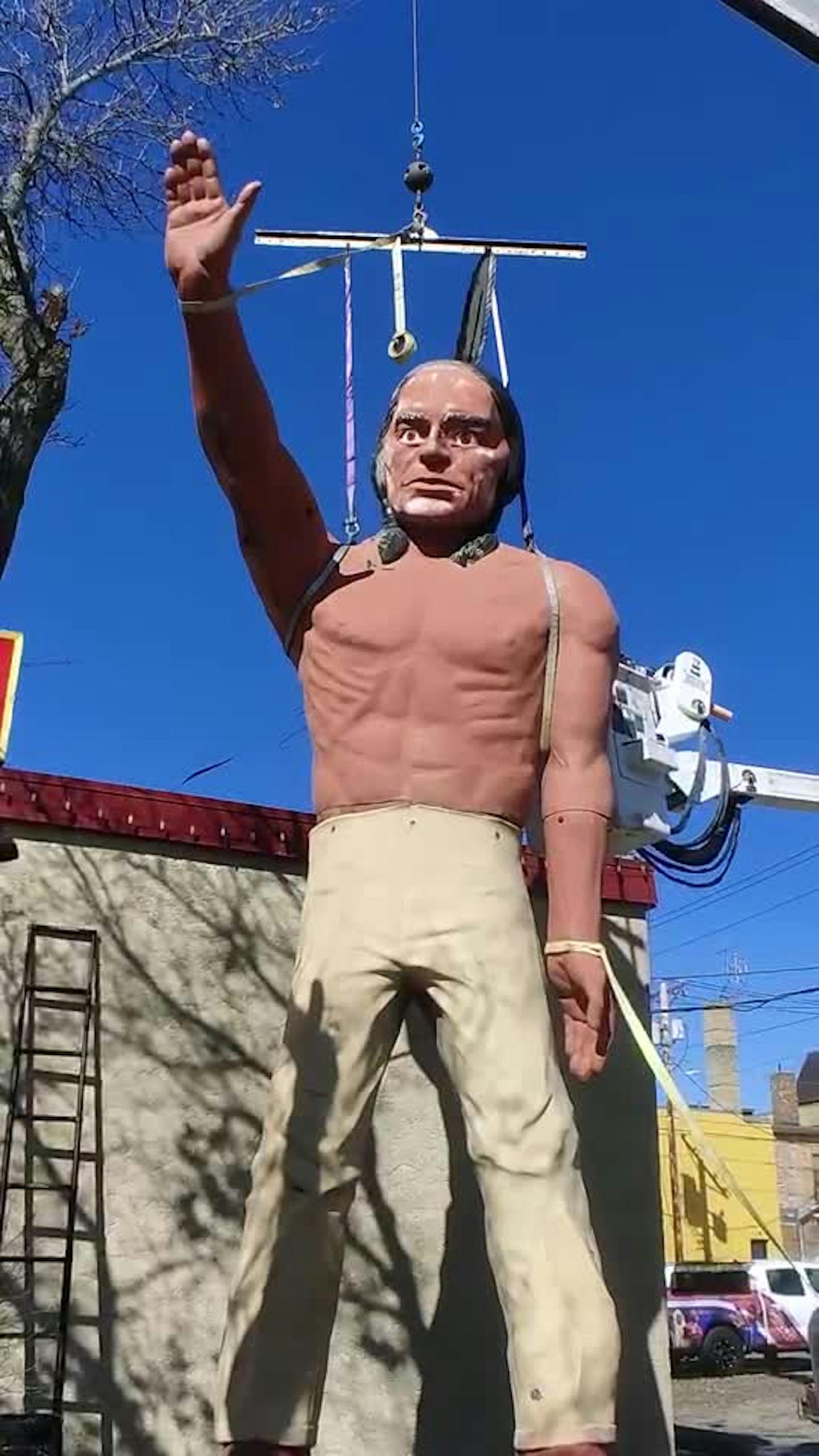Minnesota is down a Muffler Man.
One of the state's giant statues of a Native American figure is headed south to stand among other nostalgic figures in a growing museum on Route 66.
The 20-foot-tall fiberglass figure of a shirtless, saluting Native American man has gazed out at Lake Bemidji for decades. In the 1960s, when so-called Muffler Man statues began sprouting up around the country, often advertising car dealerships, gas stations and restaurants, one landed outside Morell's Chippewa Trading Post in Bemidji — not far from statues of Paul Bunyan and Babe the Blue Ox.
Over the years, the statue unofficially acquired the name Nanabozho, who, according to Ojibwe folklore, slapped Paul Bunyan in the face with a Red Lake walleye to prevent the lumberjack's clear cutting of the Chippewa National Forest. Some mistakenly refer to it as Chief Bemidji, but that's a different statue in the same neighborhood.
On Monday, a crew removed the statue's torso from his legs with a crane, disassembled his arms, then put him back together again. The chief was secured on a flatbed truck, destination Illinois.
"He left town this morning," said Roxi Mann, longtime owner of Morell's Chippewa Trading Post.
Motorists were in for a peculiar sight along the route to his destination: American Giants Museum in Atlanta, Ill. His salute looked like he was waving to passersby.
Many in town were miffed by the giant's departure, which came without warning.
Museum director Joel Baker specializes in finding and restoring old statues like the one that called Bemidji home since 1963. He said it's common for communities to grieve the loss of their own versions of the Muffler Man.
"Every town has their own story. It's always the same. You got a bunch of people that love it, they grew up with it, they want to see it stay, they're heartbroken it left," Baker said in a phone interview from his home in Colorado.
Baker added: "I'm not out there trying to scour all the giants, but here and there we're able to get one."
Mann retired and sold her business to a couple who moved the storefront down the road; she said the rent was too high to stay at the existing location. She took Baker up on his standing offer, first made several years ago, to call if she ever wanted to rehome and restore the weathered statue.
"I was kind of surprised when she called me a few months ago and said that her situation had changed and she liked the idea," he said.
Mann, 68, said she took over Morell's from her parents in 1995. The store first opened in 1948 and moved to its existing location in 1981 on the corner of Third Street and Bemidji Avenue.
She said Baker's museum is the best place for the statue.
"I didn't offer it to anyone else. I didn't feel the need to do that," she said. "I've seen their work. It's beautiful. So they will completely restore him and then he will be at their museum, but you also will be able to see him when you drive by on Route 66."
Baker is a Muffler Man connoisseur. "CBS Sunday Morning" featured him in 2023 for his work and research on International Fiberglass, the California company that came up with the 20-foot molds to make all the 400-pound Muffler Men, with slight variations to fit the particular character and arm positioning.
Muffler Man started out as Paul Bunyan, and Baker said Minnesota had many. The molds evolved to produce cowboys, "chiefs" and "braves," including the one from Bemidji.
The company stopped making the statues in the 1970s, and they are a rare find today. Baker estimates 14 braves and 14 chiefs are still standing. There are more of the Paul Bunyans, about 56 originals, he said.
The statues depicting Native Americans are the ones most often removed, from communities or businesses that "maybe didn't feel that it fit, or it was appropriate."
There were similar feelings in Bemidji. Some folks were happy to see it go, but the majority felt its loss was a travesty.
A video from myBemidji showing the statue's removal reached 76,000 views in a day and was shared by more than 400 accounts. Many commenters were divided about the outcome.
"I kind of knew once it hit a broader audience, it would not be viewed as popular because it's been here for so long," said Kevin Johnson, who owns the myBemidji gift shop and marketing business.
Baker understands the nostalgic attachment to the statue, but he said the figure was in bad shape. The crew spent three hours removing him; typically the job takes 30 minutes.
"Everything was rusted out. All the metal in him holding the legs to the torso was completely gone," Baker said, adding that the figure was one windstorm away from toppling over.
"I've never seen the top of the head completely worn into the fiberglass like he was. But no arms were missing, he even had the feather," he said. "That was great."
Baker started restoring Muffler Men a decade ago as a side hobby, "and we found that was really rewarding. They really needed to be saved."
The museum, which looks like an old Texaco gas station full of antique signs and other advertising, opened last year in partnership with the Atlanta Betterment Fund.
There will be four Muffler Men outside by May, and six by 2026 for the U.S. Route 66 centennial celebration of the country's Mother Road of motoring.
And Bemidji will be part of it.
Fall is the earliest Minnesota's contribution could be on display at the museum, Baker said. It needs a lot of TLC, and each American giant has a full panel telling its history.
Baker has mapped out Muffler Men across the country and said Minnesota has two others: a chief in Battle Lake and a Bunyan in Karlstad holding a guitar at the entrance of a music festival grounds.
It used to hold a giant hockey stick at its former home in Warroad.
Minnesota had a number of Muffler Men in St. Paul and Minneapolis, too, but Baker said many have disappeared. They were commonly the target of high school pranks and vandalism. The Warroad giant reportedly had a leg sawed off before it moved to Karlstad.
For those still standing, Baker appreciates making them available to the public instead of putting them in a private backyard.
Bemidji won't have a Muffler Man in its backyard anymore. It's now 700 miles away.
Mann said she shed a tear and waved goodbye.
"I loved it. It has been wonderful. And I've enjoyed every minute, and now I'm ready to do something else," she said. "It's good that it's evolving."

Thompson found guilty of murder in car crash that killed 5 young women

University of Minnesota is putting its golf course up for sale
Supreme Court allows DOGE team to access Social Security systems with data on millions of Americans
Feeding Our Future probe: Apple Valley woman charged with defrauding food program of $1.4 million


